






These are ROM images for use with the emulator.
| Astrocade ROM Collection | Bally Arcade/Astrocade ROM Set (Most Recent ROM Set Available) Includes Bally/Astrocade cartridge ROM images and the three available On-Board ROM files. The included files are: here. This is the most complete ROM set available. However, it does NOT include ALL ROMs that are available. Many others are available on this page and will eventually be included in this set Two versions of each ROM file are included in two different directories. One directory holds the ROMs with TOSEC filenames. The other directory holds the ROMs with names required for MAME. Everything that was officially released is here (plus far more)! Note that some of these ROMs require a real Astrocade to run and will not run with the emulator. Others will even require additional RAM for the real Astrocade. |
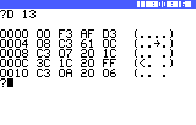 |
ADS System Monitor - Author Unknown 2K A machine language monitor program that uses an overlay. It is unknown if this program is complete. No documentation exists for this program. |
_tn.jpg) |
Bally BASIC (Prototype) - Bally 4K This prototype of the original Bally BASIC was created by Richard Degler in March of 2010 using the Bally BASIC Demo cartridge. Included in this archive is the original posting explaining the differences and what he did to create this prototype. |
 |
Bally Black Box - Steve Walters 8K Find five balls hidden in the box by sending probes into the box and seeing where they come out. Like the Parker Brothers game but with full hand-control operation and screen feed-back (no notes to keep while playing). Scoring, 1 to 4 players, and sound effects. (This is a BASIC game that has been converted by Richard Degler in December 2010 to run as a cartridge.) The exact rules for this Astrocade version of Bally Black Box are not available. For those not familiar with the concept of the Black Box game itself, read the brief directions for another version of Black Box in the Arcadian (ARCADIAN, 1, no. 9 (August 18, 1979): 74). Or, better yet, there is a Wikipedia page about Black Box that covers the rules extensively: Black Box (Game Description and Rules) on Wikipedia. |
| BallyCheck ROMs | Bally Check ROMs Adam Trionfo dumped these two ROMs on July 15, 2008 from his two different BallyCheck units; the ROMs are identical. They match perfectly with the BallyCheck source code when set for old ROM. The ROMs, for completeness, have been named: 1) BallyCheck_(Black_Version)(20002FFF)[For Bally Old ROM].bin 2) BallyCheck_(Yellow_Version)(200027FF).bin |
 |
BalCheck ("Modified") - 2K This ROM were modified by Richard Degler so that it would work in MESS without the actual BalCheck hardware device usually required. (Mar. 5, 2010) You can view some quick documentation here. |
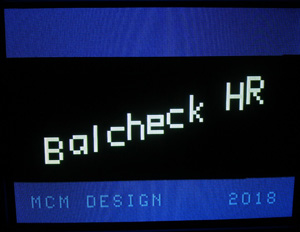 |
BalCheckHR. Three 8K ROM Images. By MCM Design (Michael Matte). 2019. This hardware allows experienced electronics users to diagnose many problems with a Bally Arcade/Astrocade game console. This device has many improvements over the original BalCheck hardware, including special routines to test Astrocade units that have been modified to use high-res mode. On the BalCheckHR hardware, this is bank 0 of the 32K ROM on the BalCheck hardware. This programs requires a keypad overlay, which is described in the user manual. This software archive includes:
|
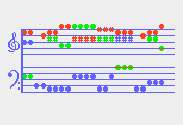 |
Beatles Music Eight different songs by The Beatles. This music was originally released on tape format by George Moses. In the mid-eighties Richard Degler converted it to cartridge format and made notes play along to the music on a musical staff. The eight original songs are: 1) A Hard Day's Night 2) Can't Buy Me Love 3) Eight Days a Week 4) I Feel Fine 5) Let It Be 6) Paperback Writer 7) She Loves You 8) YesterdayThere are also two additional versions of Yesterday and one additional version of I Feel Fine. This is a pretty complicated release, so there is a file included that goes into detail about the songs. |
(Perkins Engineering)_tn.jpg) |
Blue Ram BASIC 1.0 - Perkins Engineering 8K An early version of the more popular and standard Blue Ram BASIC 1.1 programming language. |
 |
Bumble B Cruzer/Whatzit? By Ken Lill. 198x. Blue RAM BASIC, Requires Expansion RAM. This 8K cartridge ROM image contains two games written in Blue Ram BASIC 1.1. Just like many other BASICarts, once the menu appears and the player chooses a game, then the cartridge with the games needs to be switched out with the "Blue Ram BASIC" cartridge. In "Bumble B Cruzer," formally "Star Cruser," avoid being shot by the "camera-looking" enemy while trying to get through the walls that are coming at you. You can shoot a very tiny hole in the wall. "Whatzit?" is a fast paced one player game. The object is to change all items from whatever color they are to white. Watch the start of the level for the way this is done. Each level has a different pattern. |
.jpg) |
Cartridge Tester - Ken Lill 8K This cartridge tester is used to test newly-created Bally/Astrocade cartridges. This cartridge requires expanded memory to run. For full details about this program read here. |
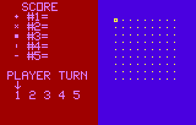 |
Claim Jumper - L&M Software 8K A BASIC program converted by Mike White to run from cartridge. |
 |
Color BASIC - (Jay Fenton with updates by Larry Hanson) 4K An updated BASIC featuring 32 colors. This cartridge was never released (this ROM is a fixed version of a prototype). This prototype didn't load programs properly, but this has been fixed by Richard Degler. Also, no manual was available, but Richard disassembled the program's binary and created documentation. It can be downloaded here. The link to the fixed version of Color BASIC includes extra files, including a full disassembly of the source code among many other extras. The original dump of this game, the one with the error when trying to use :INPUT, is still available for archival purposes. It is strongly recommended not to use this ROM, but if you want to try it out, then you can get it here. A WAV version of the unfixed ROM, with the same reservations, for use on RAM expanded Astrocades is available here. |
(Astrocade Inc.)(proto)_tn.jpg) |
Conan the Barbarian (Prototype) - Bally / Astrocade 8K A prototype of the unreleased Conan the Barbarian cartridge. |
(Astrocade Inc.)(proto)_tn.jpg) |
Cosmic Raiders (Prototype) - Astrocade 8K A prototype of the eventually released Cosmic Raiders cartridge. |
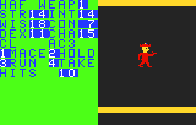 |
Fawn Dungeon - Barry McCleave 2K An incomplete machine language game written by someone that corresponded with Bob Fabris (the editor and publisher of the Arcadian newsletter). The player in this D&D-type game can wander around a randomly created maze, but there are no monsters. This is an interesting piece of what might have become something interesting. As it stands, it is little more than a programming exercise. |
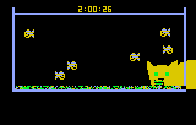 |
Goldfish Demo - The Bit Fiddlers 957 Bytes In January 2008, Lance F. Squire converted the Goldfish Demo to run as a cartridge. This is the finished conversion (version 1.4); it runs perfectly. |
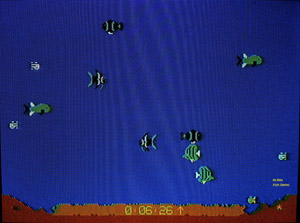 |
Hi-Res Multi-Page Test Demo By MCM Design. December 2020. Note: This cartridge will NOT work on a standard Astrocade. This program is a standard Astrocade 8K cartridge that runs on a modified Low/High-Res Astrocade with eight 16KB pages of SRAM (Static RAM) for a total of 128KB Screen RAM at a 320x204 pixel resolution each page. All necessary hi-res routines reside within the test demo program package. No user RAM above 8000H is required to run the package. A standard low-res ROM (or custom 8KB ROM at 0000-1FFFH) is required only to jump to the test demo at 2000H. This 8KB package runs in hi-res only. Here are additional files associated with this Hi-Res demo:
|
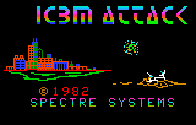 |
I.C.B.M. Attack - Spectre Systems 4K 1982 Designed by Brett Bilbrey and released into the public domain in 2001 by Brett Bilbrey, Mike Toth and Marian Nalepa (Spectre Systems). "I.C.B.M. Attack" requires a special hand controller to play on real hardware- it can NOT be played without it." While the emulator does not support this controller directly, it can be configured to play it by following the instructions: Playing ICBM Attack Using the MESS Astrocade Emulator. When playing ICBM Attack using the Astrocade MESS emulator, the game needs to be started with a Soft Reset by pressing F3. For additional details please read: "Starting ICBM Attack." |
_tn.jpg) |
I.C.B.M. Attack (Prototype) - Spectre Systems 4K 1982 Designed by Brett Bilbrey and released into the public domain in 2001 by Brett Bilbrey, Mike Toth and Marian Nalepa (Spectre Systems). "I.C.B.M. Attack" requires a special hand controller to play on real hardware- it can NOT be played without it." Paul Thacker found a prototype version of ICBM Attack on tape in the Bob Fabris collection. Unlike the previous versions found that run in BASIC, this one can only be loaded as a cartridge image into a RAM expansion. In addition to the tape recording, Paul went ahead and processed this into a binary file. This version is playable on a real system, and it also works fine in MESS. The title screen on this version is a little garbled. Paul was initially afraid that it hadn't digitally processed correctly, but there is a second recording on the same tape, and it processed into exactly the same file. While the MESS emulator does not support this controller directly, it can be configured to play it by following the instructions: Playing ICBM Attack Using the MESS Astrocade Emulator. Unlike the released version of "ICBM Attack," which needs to have a soft reset performed after turning on on the system, this prototype version does not require that to be done. A 2000-baud digitally archived tape version of this ROM image can be loaded into a RAM expansion. This version can be downloaded here. For a look at the casette tape that contained this prototype, check here. |
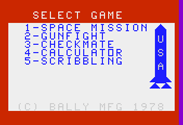 |
Menu-Demo - Michael White 4K Demonstrates how to put graphics on the menu screen. This program is VERY short, but I've upload all 4K- almost all of it is empty space. Designed by Michael White. |
| Music Decomposer | Music Decomposer - Richard Degler 4K Music Decomposer changes MUSIC STRINGS from cartridge format to AstroBASIC format. Important Note: This BASIC program is written for Blue Ram BASIC 1.1. The Music Decomposer binary works as a regular BASIC program, but it does NOT start as a cartridge. The program was on an EPROM so that it didn't have to be reloaded from tape. Check out the included, brief, instructions on how to use this program. A printout of this program is available here. |
_tn.jpg) |
Namco Font - Richard Degler ~1K This includes the Z80 source code file, as well as a pre-assembled version of the binary file that can be run in MESS. A program to display the Namco font on a Bally / Astrocade. Only 24 characters can be typed from the key-pad (mostly numbers and symbols.) So first it prints ALL the letters double-sized, followed by some of the un-reachable symbols. The six (blue) letters in my name were stored in only four characters! |
(Bally)_tn.jpg) |
On-Board '3164' ROM - Bally 8K This ROM was dumped by Paul Thacker from his very early Bally Arcade console. He comments about his system, "The system itself definitely seems early as well. In addition to the different dust cover label, the red reset button, and the silver eject button, the casing is missing most of the explanatory text such as On/Off and 3/4 for the channel." Richard Degler took a look at this ROM and has some comments, "Differences from the "3159" BIOS are the SYSTEM Routine Jump Table (since the routines are shifted), and the location of text strings and the Font (which is why to use the Dope Vector). The date starts at 3604 and is the leftover "977" of WHITE BIOS. After that the built-in games have few changes, except Gunfight plays to 9999 (like the 1978 version) and has one color changed. CHECKSUMs #1 and 2, as well as FUDGE4 are also different, so the un-modified BAL-CHECK should work fine on this machine as it is." |
_tn.gif) |
Rainbow - Version 2 - Hanson 2K A program that puts a nice 66-color display on the screen. Note that the EPROM was noted with a sticker as "Ver. 2." No earlier version of this program have been found. This archive also includes "Version 2A" with improvements by Richard Degler. Version 2A now SCROLLs. This is a slight improvement that Richard made on his way to version 3 of the program. |
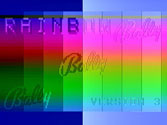 |
Rainbow - Version 3 - By Richard Degler 2K This is based on Rainbow, Ver. 2 by Hanson. Rainbow, Version 3 now has 256 colors! (July 2008) |
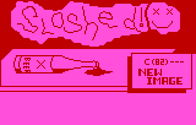 |
Sloshed - New Image 8K A BASIC program converted by Mike White to run from cartridge. Check out the title screen on this one, it's funny! The game? Well, the game is a BASIC program... |
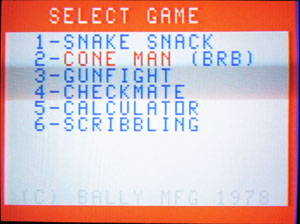
|
Snake Snack/Cone Man By Ken Lill. 1983 (Cone Man) and 1988 (Snake Snack). Blue RAM BASIC, Requires Expansion RAM. This 8K cartridge ROM image contains two games written in Blue Ram BASIC 1.1. Just like many other BASICarts, once the menu appears and the player chooses a game, then the cartridge with the games needs to be switched out with the "Blue Ram BASIC" cartridge. In Cone Man, you move an ice cream cone to the left and right, trying to catch ice cream scoops that are falling from the top of the screen. Snake Snack is similar to "Caterpillar" except that you have a maze that you are going through. When you chomp up a bit, you get longer. It IS possible to get all the bits without dying. You die when to either back over yourself or you try to cross yourself. |
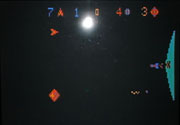 |
Solar Conqueror - Astrocade Inc 8K An early version of Solor Conqueror. |
 |
Treasure Cove - Esoterica (c)Spectre Systems 8K 1983 This cartridge was released into the public domain in 2001 by Brett Bilbrey, Mike Toth and Marian Nalepa (Spectre Systems). Written by Brett Bilbrey. |
(Alternative Engineering)(proto)_tn.jpg) |
VIPERsoft BASIC - Alternative Engineering 8K An Alternative Engineering prototype Vipersoft BASIC cartridge that contained a tape-interface. This is unusual because this BASIC was eventually released, but on tape. This version doesn't seem to be fully functional. |
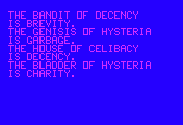 |
Words of Wisdom - W&W Software Sales 8K From: Ronaldo Goulart Received: Sat Feb 27, 2010 12:32 AM Subject: Proof of concept I just uploaded to the file area a proof of concept of what I mentioned before, I replaced the program from the Bally BASIC Demo with another one, "Words Of Wisdom by W&W", from one of the damaged recordings Adam and Paul sent me for recovery. The program is appropriate for this, as it seems to run continuously without any user input. The file is just a cartridge image inside a Zip file, so, if you wish to check it out, just load it with MESS (no special setup required). |
(Bally)(Modified by Richard Degler)_tn.jpg) |
X-Ray Maze - Bally, Modified by Richard Degler 4K This is a modified version of Amazing Maze, VideoCade #5001 (in the Strategy series) for the Bally / Astrocade. This modified version shows what the computer is thinking about instead of just the scratchpad area where it is working out the mazes. Now that you can see the maze being generated I've counted several times how many generations of a route it takes for the computer to get one that works. On the "Hard" level I've counted as high as 68 failed routes and as low as four. I did this about six times and the average seemed to be about fifty or so. So perhaps that generation of a good route after four times was a fluke. Give this program a try-- it's pretty neat to know what is going on behind-the-scenes of the maze while it is being created. |
